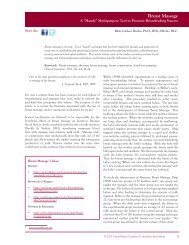Official Journal of the United States Lactation ... - Clinical Lactation
Official Journal of the United States Lactation ... - Clinical Lactation
Official Journal of the United States Lactation ... - Clinical Lactation
Create successful ePaper yourself
Turn your PDF publications into a flip-book with our unique Google optimized e-Paper software.
now categorise food in terms <strong>of</strong> its chemical<br />
composition, as do most lay writers. This almost<br />
universal perception <strong>of</strong> nutrition is evident in textbooks<br />
and scientific journals, and on food labels,<br />
journalism, and “diet books.” The identification<br />
<strong>of</strong> food with its chemistry is a defining characteristic<br />
<strong>of</strong> modern nutrition science, as invented in<br />
<strong>the</strong> early 19th century. Seeing food in terms <strong>of</strong><br />
its chemistry has enabled <strong>the</strong> industrialization <strong>of</strong><br />
food systems. In particular, it has made possible<br />
<strong>the</strong> formulation <strong>of</strong> ultra-processed products from<br />
“refined” or “purified” chemical constituents <strong>of</strong><br />
foods-oils, proteins, carbohydrates, and <strong>the</strong>ir fractions—toge<strong>the</strong>r<br />
with “micronutrients”—vitamins<br />
and minerals (Monteiro, 2011).<br />
He summarizes: “Identification <strong>of</strong> food mainly with its<br />
chemical constituents at best has limited value, and in<br />
general has proved to be unhelpful, misleading, and<br />
harmful to public health.”<br />
The Codex Statement on Infant Formula <strong>of</strong> 1976 said,<br />
“Numerous formulae have been produced which <strong>of</strong>fer a<br />
nutritionally adequate food for infants . . .” (Codex<br />
Alimentarius, 1976). That depends on how one understands<br />
“nutritionally adequate.” Elsewhere <strong>the</strong> Codex<br />
Alimentarius Commission said:<br />
The nutritional adequacy <strong>of</strong> a product can be<br />
defined in terms <strong>of</strong> protein quality and quantity,<br />
and content <strong>of</strong> minerals and vitamins.<br />
Such a product should be considered nutritionally<br />
equivalent if:<br />
i. its protein quality is not less than that <strong>of</strong> <strong>the</strong><br />
original product or is equivalent to that <strong>of</strong><br />
casein, and<br />
ii.<br />
it contains <strong>the</strong> equivalent quantity <strong>of</strong> protein<br />
(N=6.25) and those vitamins and minerals<br />
which are present in significant amounts<br />
in <strong>the</strong> original animal products (Codex<br />
Alimentarius Commission, 1989).<br />
This is difficult to understand. A food’s nutritional adequacy<br />
should be assessed in terms <strong>of</strong> its results, not its<br />
ingredients. Infant formula should be viewed as nutritionally<br />
adequate only if it is proven to be as good for<br />
children as breastfeeding. Any o<strong>the</strong>r definition shortchanges<br />
children.<br />
The overall quality <strong>of</strong> infant-formula products should be<br />
assessed on <strong>the</strong> basis <strong>of</strong> <strong>the</strong>ir safety and <strong>the</strong>ir nutritional<br />
adequacy. Assessing infant formulas only on <strong>the</strong> basis <strong>of</strong><br />
<strong>the</strong>ir safety and <strong>the</strong>ir composition (as in Crawley, 2011)<br />
is a serious error. Studying <strong>the</strong> composition <strong>of</strong> infant<br />
formula is <strong>of</strong> little help in assessing <strong>the</strong> risks involved in<br />
its use.<br />
There is value to checking <strong>the</strong> composition <strong>of</strong> infant formula<br />
because it can deteriorate over time, it may be<br />
manufactured improperly, and it may be contaminated<br />
in various ways. However, that is not <strong>the</strong> same as checking<br />
for nutritional adequacy. Even perfect adherence to<br />
imperfect recipes for infant formula puts infants at risk.<br />
The main function <strong>of</strong> infant food and <strong>the</strong> associated<br />
feeding process is to ensure long-term health—including<br />
not only body-building, but also protection against infections<br />
and allergies, and facilitating cognitive as well as<br />
physical development. The only way to ensure that feeding<br />
with any breast-milk substitute is equivalent to<br />
breastfeeding would be to compare <strong>the</strong> health <strong>of</strong> children<br />
who are breastfed with <strong>the</strong> health <strong>of</strong> those who use<br />
<strong>the</strong> substitute, not only in <strong>the</strong> short term, but also in <strong>the</strong><br />
long term.<br />
In 1981, <strong>the</strong> Codex Alimentarius Commission said:<br />
Infant formula means a breast-milk substitute<br />
specially manufactured to satisfy, by itself, <strong>the</strong><br />
nutritional requirements <strong>of</strong> infants during <strong>the</strong> first<br />
months <strong>of</strong> life up to <strong>the</strong> introduction <strong>of</strong> appropriate<br />
complementary feeding (Codex Alimentarius<br />
Commission 2007, Section 2.1.1).<br />
If we assess formula by its results, ra<strong>the</strong>r than by whe<strong>the</strong>r<br />
its ingredients matched a specific list, we would have to<br />
conclude that <strong>the</strong>re has never been an infant formula<br />
that would “satisfy, by itself, <strong>the</strong> nutritional requirements<br />
<strong>of</strong> infants during <strong>the</strong> first months <strong>of</strong> life.”<br />
Contrary to Codex’s 1976 claim that, “Numerous formulae<br />
have been produced which <strong>of</strong>fer a nutritionally<br />
adequate food for infants” (Codex Alimentarius, 1976),<br />
<strong>the</strong>re has never been any infant formula that is nutritionally<br />
adequate.<br />
The European Union said, “Infant formula is <strong>the</strong> only<br />
processed foodstuff which wholly satisfies <strong>the</strong> nutritional<br />
requirements <strong>of</strong> infants during <strong>the</strong> first months <strong>of</strong><br />
life until <strong>the</strong> introduction <strong>of</strong> appropriate complementary<br />
feeding” (EUR-Lex 2011, para 4; also see Article 2(c)<br />
© 2012 <strong>United</strong> <strong>States</strong> <strong>Lactation</strong> Consultant Association 23




